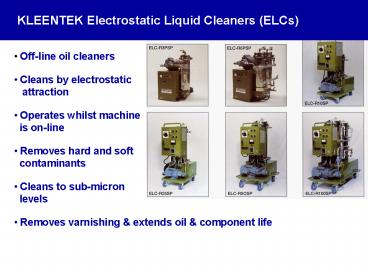KLEENTEK Electrostatic Liquid Cleaners ELCs - PowerPoint PPT Presentation
1 / 28
Title:
KLEENTEK Electrostatic Liquid Cleaners ELCs
Description:
Microscopic photo of black spots. Sparks occur between centre core. and pleated edges. ... Gear oils. Thermal oils. Compressor oils. Mineral oil cutting fluids ... – PowerPoint PPT presentation
Number of Views:660
Avg rating:3.0/5.0
Title: KLEENTEK Electrostatic Liquid Cleaners ELCs
1
KLEENTEK Electrostatic Liquid Cleaners (ELCs)
2
KLEENTEK Electrostatic Liquid Cleaners (ELCs)
85 of all problems in hydraulic systems are
caused by contaminated oil Fluid Power
Transmission Group
Conventions dictate need for high cleanliness
using ISO or NAS standards
There are many contaminants not represented by
ISO or NAS standards. What are they? Where do
they come from? What do they cause? How are
they detected? How they are controlled?
3
KLEENTEK Electrostatic Liquid Cleaners (ELCs)
- HARD - Wear metals, dust,etc.
- WATER - free or emulsified
- SOFT - Oxidation products, depleted
additives
The norm is to look at the top two Many believe
soft contaminant to be harmless WRONG!
4
KLEENTEK Electrostatic Liquid Cleaners (ELCs)
Identifies all insoluble Contaminants. Can be
used on-site
5
KLEENTEK Electrostatic Liquid Cleaners (ELCs)
- Measured against ISO and NAS standards, based on
particle count
With this you can estimate The ISO or NAS
particle count grade
- Measure particles gt 5µm
- Majority of particles are lt 5 µm
- Measurement does not show
- levels of soft contaminants
50 x magnified view of the patch
6
KLEENTEK Electrostatic Liquid Cleaners (ELCs)
- Include sub-micron hard particles, oxidation
products depleted additives - Measured by drawing oil through
- .8 µm patch and view discoloration
- Such contaminants are not represented by ISO or
NAS standards - Such contaminants are mainly sub-micron, so are
not removed by conventional filters
7
KLEENTEK Electrostatic Liquid Cleaners (ELCs)
8
KLEENTEK Electrostatic Liquid Cleaners (ELCs)
9
KLEENTEK Electrostatic Liquid Cleaners (ELCs)
10
KLEENTEK Electrostatic Liquid Cleaners (ELCs)
Source Dr Akira Sasaki
11
KLEENTEK Electrostatic Liquid Cleaners (ELCs)
So oxidation products are the largest group
12
KLEENTEK Electrostatic Liquid Cleaners (ELCs)
Initiation (Oil Molecules must be sheared) RH
R H .. (1)
(Oil oxidation starts by shearing oil
molecules and producing free radicals) Propagatio
n R O2 ROO ..
(2) (Production of Peroxy Radicals) ROO
RH ROOH R . (3)
(Production of Hydro-peroxide)
13
KLEENTEK Electrostatic Liquid Cleaners (ELCs)
- Oxygen and oil molecules react - form new
compounds - Air dissolves in oil to around 10 volume at
atmospheric pressure (Henrys Law) - Oxidation rate doubles for
- every 10C above 45C
- Other contaminants act as catalysts
So all oil systems get it to varying degrees
14
KLEENTEK Electrostatic Liquid Cleaners (ELCs)
Sparks occur between centre core and pleated
edges. (In 3 months use)
Microscopic photo of black spots
15
KLEENTEK Electrostatic Liquid Cleaners (ELCs)
Initially soluble Polymerisation
agglomeration Insoluble Act like
contaminants
Alcohols Aldehydes Ketones Saturated
esters Lactones Peroxides (unstable
products) Carbon monoxide Carbon dioxide Organic
acid (TAN) Polymerised hydrocarbons
(Sludge) Water
16
KLEENTEK Electrostatic Liquid Cleaners (ELCs)
- Free particles, including oxidation products, are
polar - As a result, they attach themselves to the oil
system internals including seals, bearings,
valves etc
17
KLEENTEK Electrostatic Liquid Cleaners (ELCs)
Gradually layers build up, leading to
Filter or strainer blockage
Sticking valves
Seal deterioration
Dirty maintenance environment
Sandpaper effect on moving parts
18
KLEENTEK Electrostatic Liquid Cleaners (ELCs)
- Form coatings on internal surfaces increased
friction - Coatings lead to Stick- Slip on moving parts
- Sticky coatings Glue hard particles wear
- Oxidation products attack seals leaks
- Oxidation process depletes Anti-Oxidants
reduced oil life - During oxidation process acidic by-products are
formed - Oxidation products encourage further break-down
of the oil
19
KLEENTEK Electrostatic Liquid Cleaners (ELCs)
Portable stand alone unit
20
KLEENTEK Electrostatic Liquid Cleaners (ELCs)
Oil is drawn from the reservoir and passed
between a series of Anodes and Cathodes The
polar contaminants are attracted out of the oil
and into a Collector
21
KLEENTEK Electrostatic Liquid Cleaners (ELCs)
- Electrophoresis
- Dielectrophoresis
- Polar contaminants are attracted to their
opposite electrode - Neutral particles are collected as they move
towards areas of high field intensity created by
the Collector material
22
KLEENTEK Electrostatic Liquid Cleaners (ELCs)
If the discoloration is maintained at low levels
this means oil Is below saturation, at which
point dirt is removed from internals
Above saturation
Below saturation
Used oil 3µm filter 1 year old
Same used oil Cleaned with KLEENTEK ELC
New oil
0.8µm membrane
23
KLEENTEK Electrostatic Liquid Cleaners (ELCs)
So Kleentek cleans the system, not just the oil.
But this takes time
24
KLEENTEK Electrostatic Liquid Cleaners (ELCs)
- Collectors are replaced every 2000 hours
- This ensures cleaning efficiency is maintained
- Procedure takes 30 minutes
25
KLEENTEK Electrostatic Liquid Cleaners (ELCs)
This example illustrates how KLEENTEK has removed
deposits from the inside of the machines
pipe-work
Before applying ELC
After applying ELC
26
KLEENTEK Electrostatic Liquid Cleaners (ELCs)
Main influences are oil volume, viscosity and
system type nature
27
KLEENTEK Electrostatic Liquid Cleaners (ELCs)
- Suitable for
- Hydraulic oils
- Circulating/lube oils
- Gear oils
- Thermal oils
- Compressor oils
- Mineral oil cutting fluids
- Transformer oils
- Not suitable for
- Water based fluids
- Engine oils
- Some synthetics
28
KLEENTEK Electrostatic Liquid Cleaners (ELCs)
Cost savings - Reduced oil changes
top-ups Reduced valve/pump/brg etc
changes Reduced filter changes Reduced
power consumption Increased - Increased
up-time output Improved cycle times Improved
planned maintenance More proactive maintenance
regime Environment - Reduced leaks Reduced
oil changes Cleaner machine internals and
externals Bottom line - Reduced maintenance
cost Increased output

